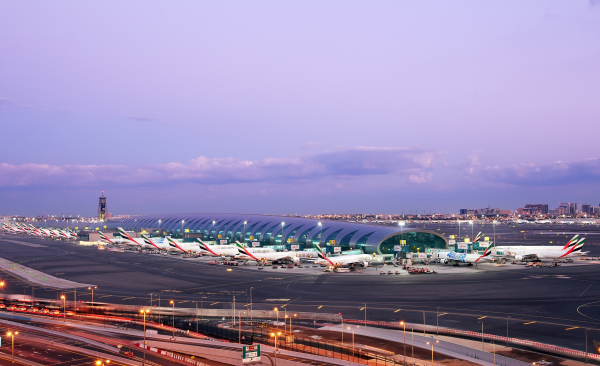DUBAI, UAE, 11 May 2020: Emirates Group announced Sunday its 32nd consecutive year of profit, against a drop in revenue mainly attributed to reduced operations during the planned DXB runway closure in the first quarter, and the impact of flight and travel restrictions due to the COVID-19 pandemic in the fourth quarter.
Released at the weekend, the 2019-20 Annual Report confirms Emirates Group posted a profit of AED1.7 billion (USD456 million) for the financial year ended 31 March 2020, down 28% from last year.

The Group’s revenue reached AED 104.0 billion (USD28.3 billion), a decline of 5% over last year’s results. The Group’s cash balance was AED 25.6 billion (USD7 billion), up 15% from last year mainly due to a strong business performance up to February 2020 and lower fuel cost compared to the previous year.
Due to the unprecedented business environment from the ongoing pandemic, and to protect the Group’s liquidity position, the Group has not declared a dividend for this financial year after last year’s dividend of AED 500 million (USD136 million) to the Investment Corporation of Dubai.
Emirates Airline and Group chairman and chief executive, HE Sheikh Ahmed bin Saeed Al Maktoum said: “For the first 11 months of 2019-20, Emirates and dnata were performing strongly, and we were on track to deliver against our business targets. However, from mid-February things changed rapidly as the COVID-19 pandemic swept across the world, causing a sudden and tremendous drop in demand for international air travel as countries closed their borders and imposed stringent travel restrictions.”
In 2019-20, the Group collectively invested AED 11.7 billion (USD3.2 billion) in new aircraft and equipment, the acquisition of companies, modern facilities, the latest technologies, and employee initiatives, a decrease following last year’s record investment spend of AED 14.6 billion (USD3.9 billion). It also continued to invest resources towards supporting communities, environmental initiatives, as well as incubator programmes that nurture talent and innovation to support future industry growth.
At the 2019 Dubai Air Show in November, Emirates placed a US$ 16 billion order for 50 A350 XWBs, and a USD8.8 billion order for 30 Boeing 787 Dreamliner aircraft. With first deliveries expected in 2023, these new aircraft will add to Emirates’ current fleet mix, and provide deployment flexibility within its long-haul hub model. In line with Emirates’ long-standing strategy to operate a modern and efficient fleet, these new aircraft will also keep its fleet age well below the industry average.
Emirates performance
Emirates’ total passenger and cargo capacity declined by 8% to 58.6 billion ATKMs at the end of 2019-20, due to the DXB runway closure capacity restrictions and Covid-19 impact with a complete suspension of passenger services as directed by the UAE government during March 2020.
Emirates received six new aircraft during the financial year, all A380s. During 2019-20, Emirates phased out six older aircraft comprising of four Boeing 777-300ERs, its last 777-300 and one Boeing 777 freighter leaving its total fleet count unchanged at 270 at the end of March. Emirates’ average fleet age remains at a youthful 6.8 years.
It reinforces Emirates’ strategy to operate a young and modern fleet, and live up to its “Fly Better” brand promise as modern aircraft are better for the environment, better for operations, and better for customers.
During the year, Emirates launched three new passenger routes: Porto (Portugal), Mexico City (Mexico) and Bangkok-Phnom Penh. It also supplemented its organic network growth with a new codeshare agreement signed with Spicejet that will provide Emirates customers with more connectivity options in India.
Additionally, Emirates expanded its global connectivity and customer proposition through interline agreements with Vueling, adding connections to over 100 destinations around Europe via Barcelona, Madrid, Rome and Milan; with Turkish low-cost airline Pegasus Airline (PC), offering customers connections onto selected routes on PC’s network; and with Interjet Airlines, opening new routes for passengers travelling between Mexico, the Gulf and the Middle East and beyond.
Emirates also marked two years of a successful strategic partnership with flydubai. Over 5.3 million passengers have benefitted from seamless connectivity on the Emirates and flydubai network since both Dubai-based airlines began their partnership in October 2017.
While Emirates recorded a very strong revenue performance during its 2nd and 3rd quarters of 2019-20, the DXB runway closure and Covid-19 crisis in the other quarters impacted its total revenue for the financial year with a decline of 6% to AED 92.0 billion (USD25.1 billion). The relative strengthening of the US dollar against currencies in many of Emirates’ key markets had an AED 963 million (USD262 million) negative impact to the airline’s bottom line, a substantial increase compared to the previous year’s negative currency impact of AED 572 million (USD156 million).
Total operating costs decreased by 10% over the 2018-19 financial year. The average price of jet fuel declined by 9% during the financial year after last year’s 22% increase. Including a 6% lower uplift in line with capacity reduction, the airline’s fuel bill declined substantially by 15% over last year to AED 26.3 billion (US$ 7.2 billion) and accounted for 31% of operating costs, compared to 32% in 2018-19. Fuel remained the biggest cost component for the airline.
Despite continued strong competitive pressure and the unfavourable currency impact, the airline reported a profit of AED1.1 billion (USD 288 million), an increase of 21% over last year’s results, and a profit margin of 1.1%. Profit would have been higher without a loss of AED 1.1 billion (US$ 299 million) due to fuel hedge ineffectiveness at year-end.
Overall passenger traffic declined, as Emirates carried 56.2 million passengers (down 4%). With seat capacity down by 6%, the airline achieved a Passenger Seat Factor of 78.5%. The positive development in passenger seat factor compared to last year’s 76.8%, reflects the airline’s successful capacity management and positive travel demand across nearly all markets up until the outbreak of Covid-19 in the last quarter.
The full 2019-20 Annual Report of the Emirates Group – comprising Emirates, dnata and their subsidiaries – is available here.







